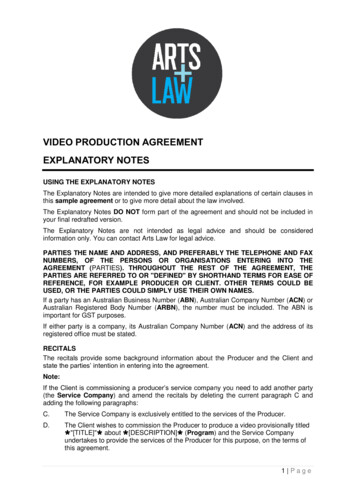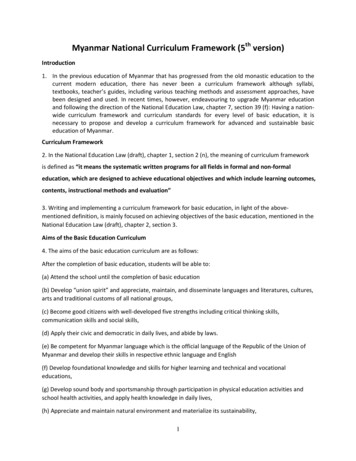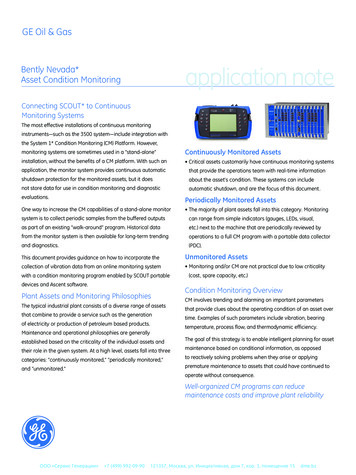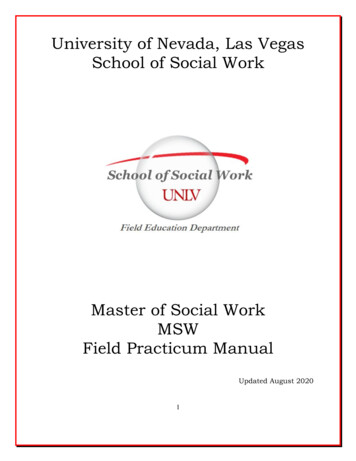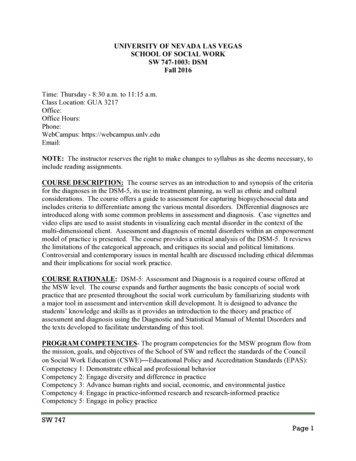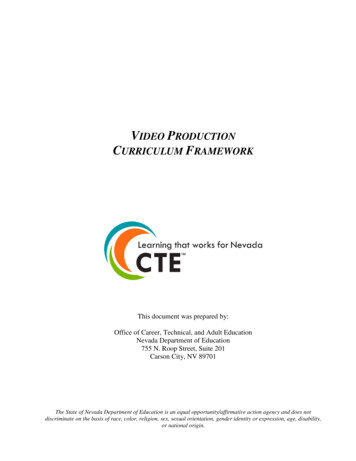
Transcription
VIDEO PRODUCTIONCURRICULUM FRAMEWORKThis document was prepared by:Office of Career, Technical, and Adult EducationNevada Department of Education755 N. Roop Street, Suite 201Carson City, NV 89701The State of Nevada Department of Education is an equal opportunity/affirmative action agency and does notdiscriminate on the basis of race, color, religion, sex, sexual orientation, gender identity or expression, age, disability,or national origin.
NEVADA CTE CURRICULUM FRAMEWORK2013INTRODUCTIONThe Nevada CTE Curriculum Frameworks are a resource for Nevada’s public and charter schools to design,implement, and assess their CTE programs and curriculum. The content standards identified in this documentare listed as a model for the development of local district programs and curriculum. They represent rigorousand relevant expectations for student performance, knowledge, and skill attainment which have been validatedby industry representatives.The intent of this document is to provide a resource to districts as they develop and implement CTE programsand curricula.This program ensures the following thresholds are met: The CTE course and course sequence teaches the knowledge and skills required by industrythrough applied learning methodology and, where appropriate, work-based learningexperiences that prepare students for careers in high-wage, high-skill and/or high-demandfields. Regional and state economic development priorities shall play an important role indetermining program approval. Some courses also provide instruction focused on personaldevelopment.The CTE course and course sequence includes leadership and employability skills as anintegral part of the curriculum.The CTE course and course sequence are part of a rigorous program of study and includesufficient technical challenge to meet state and/or industry-standards.The CTE program components include the following items: Program of StudyState Skill StandardsEmployability Skills for Career Readiness StandardsCareer Technical Student Organizations (CTSO)Curriculum FrameworkCTE Assessments: Workplace Readiness Skills Assessment End-of-Program Technical AssessmentCertificate of Skill AttainmentCTE Endorsement on a High School DiplomaCTE College CreditRevised: 03/05/2015Video Production1
NEVADA CTE CURRICULUM FRAMEWORK2013NEVADA DEPARTMENT OF EDUCATIONCURRICULUM FRAMEWORK FORVIDEO PRODUCTIONPROGRAM TITLE: VIDEO PRODUCTIONSTATE SKILL STANDARDS: VIDEO PRODUCTIONSTANDARDS REFERENCE CODE: VIDEOCAREER CLUSTER : ARTS, A/V TECHNOLOGY & COMMUNICATIONCAREER PATHWAY:AUDIO & VIDEO TECHNOLOGY & FILMJOURNALISM & BROADCASTINGPROGRAM LENGTH: 3 LEVELS (L1, L2, L3C)PROGRAM ASSESSMENTVIDEO PRODUCTIONWORKPLACE READINESS SKILLSCTSO: SKILLSUSAGRADE LEVEL: 9-12AVAILABLE INDUSTRYCERTIFICATIONS/LICENSESPROVIDERS:PROGRAM PURPOSEThe purpose of this program is to prepare students for postsecondary education and employment in the VideoProduction industry.The program includes the following state standards: Nevada CTE Skill Standards: Video ProductionEmployability Skills for Career ReadinessNevada Academic Content Standards (alignment shown in the Nevada CTE Skill Standards): Science (based on the Next Generation Science Standards) English Language Arts (based on the Common Core State Standards) Mathematics (based on the Common Core State Standards)Common Career Technical Core (alignment shown in the Nevada CTE Skill Standards)CAREER CLUSTERSThe National Career Clusters Framework provides a vital structure for organizing and delivering qualityCTE programs through learning and comprehensive programs of study (POS). In total, there are 16 CareerClusters in the National Career Clusters Framework, representing more than 79 Career Pathways to helpstudents navigate their way to greater success in college and career. As an organizing tool for curriculumdesign and instruction, Career Clusters provide the essential knowledge and skills for the 16 CareerClusters and their Career Pathways.**Cite: National Association of State Directors of Career Technical Education Consortium. (2012). Retrievedfrom areerclusters.htmlRevised: 03/05/2015Video Production2
NEVADA CTE CURRICULUM FRAMEWORK2013PROGRAM OF STUDYThe program of study illustrates the sequence of academic and career and technical education coursework thatis necessary for the student to successfully transition into postsecondary educational opportunities andemployment in their chosen career path. (NAC 389.803)PROGRAM STRUCTUREThe core course sequencing provided in the following table serves as a guide to schools for their programs ofstudy. Each course is listed in the order in which it should be taught and has a designated level. Completeprogram sequences are essential for the successful delivery of all state standards in each program area.VIDEO PRODUCTIONCore Course SequenceCOURSE NAMELEVELVideo Production IVideo Production IIVideo Production IIIL1L2L3CThe core course sequencing with the complementary courses provided in the following table serves as a guideto schools for their programs of study. Each course is listed in the order in which it should be taught and hasa designated level. A program does not have to utilize all of the complementary courses in order for theirstudents to complete their program of study. Complete program sequences are essential for the successfuldelivery of all state standards in each program area.VIDEO PRODUCTIONCore Course Sequence with Complementary CoursesCOURSE NAMELEVELVideo Production IVideo Production IIVideo Production II LAB*Video Production IIIVideo Production III LAB*Video Production Advanced Studies**Complementary CoursesL1L2L2LL3CL3LASSTATE SKILL STANDARDSThe state skill standards are designed to clearly state what the student should know and be able to do uponcompletion of an advanced high school career and technical education (CTE) program. The standards aredesigned for the student to complete all standards through their completion of a program of study. Thestandards are designed to prepare the student for the end-of-program technical assessment directly aligned tothe standards. (Paragraph (a) of Subsection 1 of NAC 389.800)Revised: 03/05/2015Video Production3
NEVADA CTE CURRICULUM FRAMEWORK2013EMPLOYABILITY SKILLS FOR CAREER READINESS STANDARDSEmployability skills, often referred to as “soft skills”, have for many years been a recognizable component ofthe standards and curriculum in career and technical education programs. The twenty-one standards areorganized into three areas: (1) Personal Qualities and People Skills; (2) Professional Knowledge and Skills;and (3) Technology Knowledge and Skills. The standards are designed to ensure students graduate highschool properly prepared with skills employers prioritize as the most important. Instruction on all twenty-onestandards must be part of each course of the CTE program. (Paragraph (d) of Subsection 1 of NAC 389.800)CURRICULUM FRAMEWORKThe Nevada CTE Curriculum Frameworks are organized utilizing the recommended course sequencing listedin the Program of Study and the CTE Course Catalog. The framework identifies the recommended contentstandards, performance standards, and performance indicators that should be taught in each course.CAREER AND TECHNICAL STUDENT ORGANIZATIONS (CTSOS)To further the development of leadership and technical skills, students must have opportunities to participatein one or more of the Career and Technical Student Organizations (CTSOs). CTSOs develop character,citizenship, and the technical, leadership and teamwork skills essential for the workforce and their furthereducation. Their activities are considered a part of the instructional day when they are directly related to thecompetencies and objectives in the course. (Paragraph (a) of Subsection 3 of NAC 389.800)WORKPLACE READINESS SKILLS ASSESSMENTThe Workplace Readiness Skills Assessment has been developed to align with the Nevada CTEEmployability Skills for Career Readiness Standards. This assessment provides a measurement of studentemployability skills attainment. Students who complete a program will be assessed on their skill attainmentduring the completion level course. Completion level courses are identified by the letter “C”.(e.g., Level L3C) (Paragraph (d) of Subsection 1 of NAC 389.800)END-OF-PROGRAM TECHNICAL ASSESSMENTAn end-of-program technical assessment has been developed to align with the Nevada CTE Skill Standardsfor this program. This assessment provides a measurement of student technical skill attainment. Studentswho complete a program will be assessed on their skill attainment during the completion level course.Completion level courses are identified by the letter “C”. (e.g., Level L3C)(Paragraph (e) of Subsection 1 of NAC 389.800)CERTIFICATE OF SKILL ATTAINMENTEach student who completes a course of study must be awarded a certificate which states that they haveattained specific skills in the industry being studied and meets the following criteria: A student must maintaina 3.0 grade point average in their approved course of study, pass the Workplace Readiness Skills Assessment,and pass the end-of-program technical assessment. (Subsection 4 of NAC 389.800)CTE ENDORSEMENT ON A HIGH SCHOOL DIPLOMAA student qualifies for a CTE endorsement on their high school diploma after successfully completing thefollowing criteria: 1) successful completion of a CTE course of study in a program area, 2) successfulcompletion of academic requirements governing receipt of a standard diploma, and 3) meet all requirementsfor the issuance of the Certificate of Skill Attainment. (NAC 389.815)Revised: 03/05/2015Video Production4
NEVADA CTE CURRICULUM FRAMEWORK2013CTE COLLEGE CREDITCTE College Credit is awarded to students based on articulation agreements established by each college forthe CTE program, where the colleges will determine the credit value of a full high school CTE program basedon course alignment. An articulation agreement will be established for each CTE program designating thenumber of articulated credits each college will award to students who complete the program.CTE College Credit is awarded to students who: (1) complete the CTE course sequence with a grade-pointaverage of 3.0 or higher; (2) pass the state end-of-program technical assessment for the program; and (3) passthe Workplace Readiness Assessment for employability skills.Pre-existing articulation agreements will be recognized until new agreements are established according tocurrent state policy and the criteria shown above.Please refer to the local high school’s course catalog or contact the local high school counselor for moreinformation. (Paragraph (b) of Subsection 3 of NAC 389.800)ACADEMIC CREDIT FOR CTE COURSEWORKCareer and technical education courses meet the credit requirements for high school graduation (1 unit of artsand humanities or career and technical education). Some career and technical education courses meetacademic credit for high school graduation. Please refer to the local high school’s course catalog or contactthe local high school counselor for more information. (NAC 389.672)Revised: 03/05/2015Video Production5
NEVADA CTE CURRICULUM FRAMEWORK2013CORE COURSE:RECOMMENDED STUDENT PERFORMANCE STANDARDSCOURSE TITLE:Video Production IABBR. NAME: VIDEO PROD ICREDITS:LEVEL:CIP SE DESCRIPTIONThis course is designed to introduce students to the basic elements and skills needed to produce a video. Operatingvideo cameras, script writing, editing equipment, microphones, and the process of On-Air program production areemphasized. Students will become familiar with video production techniques for a variety of purposes, includingbroadcast journalism.TECHNICAL STANDARDSCONTENT STANDARD 1.0 :Performance Standard 1.1 :Performance Indicators :Performance Standard 1.2 :Performance Indicators :Performance Standard 1.3 :Performance Indicators :Performance Standard 1.4 :Performance Indicators :Performance Standard 1.5 :Performance Indicators :CONTENT STANDARD 2.0 :Performance Standard 2.1 :Performance Indicators :Performance Standard 2.2 :Performance Indicators :CONTENT STANDARD 3.0 :Performance Standard 3.1 :Performance Indicators :Performance Standard 3.2 :Performance Indicators :Performance Standard 3.3 :Performance Indicators :Performance Standard 3.4 :Performance Indicators :EXAMINE THE VIDEO PRODUCTION INDUSTRYResearch Events That Led to Current Practices1.1.1-1.1.3Investigate Industry Ethics and Laws1.2.1-1.2.7Explain the Stages of the Video Production Process1.3.1-1.3.7Investigate the Various Roles in Video Production1.4.1-1.4.2Explore Careers in the Video Industry1.5.1-1.5.3SAFETY AND PERSONAL RESPONSIBILITY IN THE WORKPLACEMaintain an Orderly and Safe Work Environment2.1.1-2.1.4Demonstrate Personal Responsibility and Professionalism2.2.1-2.2.4DEMONSTRATE THE USE OF VIDEO PRODUCTION EQUIPMENTDemonstrate Camera Operation and Techniques3.1.1-3.1.7Demonstrate the Use of Audio Equipment Operation3.2.1-3.2.7Demonstrate Proper Lighting Techniques3.3.1-3.3.4Demonstrate Effective Use of Visual Effects and Computer Graphics3.4.2-3.4.3 .continue on next pageRevised: 03/05/2015Video Production6
NEVADA CTE CURRICULUM FRAMEWORKCONTENT STANDARD 4.0 :Performance Standard 4.1 :Performance Indicators :Performance Standard 4.2 :Performance Indicators :Performance Standard 4.3 :Performance Indicators :CONTENT STANDARD 5.0 :Performance Standard 5.1 :Performance Indicators :Performance Standard 5.2 :Performance Indicators :Performance Standard 5.3 :Performance Indicators :CONTENT STANDARD 6.0 :Performance Standard 6.1 :Performance Indicators :Performance Standard 6.2 :Performance Indicators :Performance Standard 6.3 :Performance Indicators :Performance Standard 6.4 :Performance Indicators :2013WRITING FOR VIDEO PRODUCTIONConduct Research for Projects4.1.1-4.1.6Create Scripts and Storyboards4.2.1-4.2.6De
vised: 03 /05 20 15 Video Production I NTRODUCTION The Nevada CTE Curriculum Frameworks are a resource for Nevada’s public and charter schools to design, implement, and assess their CTE programs and curriculum. The content standards identified in this document are listed as a model for the development of local district programs and curriculum. They represent rigorous

